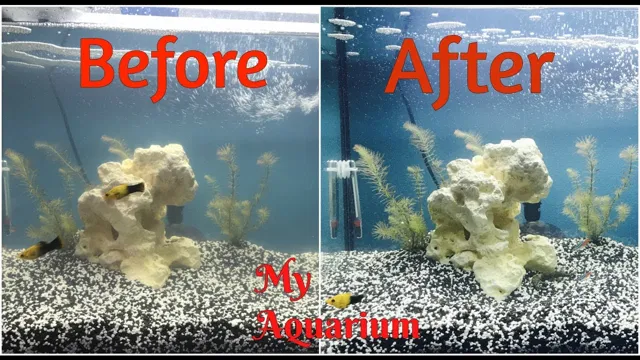Aquariums are a beautiful and tranquil addition to any home, but it’s essential to ensure that all elements inside are safe for the fish and other aquatic life living in it. One of the essential components of an aquarium is the rocks. Not only do they add a natural and aesthetic appeal, but they also mimic the natural habitat of the fish.
However, not all rocks are aquarium-safe, and some can harm the aquatic life and alter the water chemistry in adverse ways. So, how do you pick the right rocks for your aquarium? That’s what we will discuss in this blog. We’ll go over the types of rocks you can use and how to make sure they are safe to use in your aquarium.
Let’s dive into it!
Introduction
If you’re thinking of setting up an aquarium, you might be wondering how to make aquarium-safe rocks. One of the primary concerns when creating an aquatic environment is to ensure that the rocks used are safe for the fish and other inhabitants. Many rocks from natural sources can leach harmful chemicals into the water, so it’s essential to choose carefully.
First, it’s crucial to avoid using rocks that have been treated or painted, as these can release toxic substances. Secondly, you should opt for igneous or sedimentary rocks, which are more stable and less likely to break down in water. Lastly, it’s best to use aquarium-safe rocks that have been purchased from a reputable store that specializes in aquarium supplies.
With careful selection and planning, you can create a beautiful and safe aquarium for your aquatic pets.
What makes rocks unsafe for aquariums?
Rocks can be a great addition to any aquarium, adding visual interest and providing hiding spaces for your aquatic pets. However, not all rocks are suitable for aquariums. Using the wrong type of rock can be incredibly dangerous for your fish and other aquatic pets.
Rocks that are unsafe for aquariums can release harmful chemicals into the water, causing health issues or even death for your pets. Additionally, certain rocks can alter the pH level of the water, making it difficult to maintain a healthy environment for your fish. It’s important to research and carefully choose the right type of rock for your aquarium to ensure the safety and well-being of your aquatic pets.
By doing so, you can create a beautiful and thriving underwater ecosystem that both you and your pets will enjoy.

Why is it important to use aquarium safe rocks?
Aquarium safe rocks are vital when it comes to maintaining a healthy and thriving aquatic environment. These types of rocks are specifically designed to meet the needs of aquarium life and do not contain any harmful chemicals or minerals that could harm plants or animals. Using non-aquarium safe rocks can lead to toxicity, high levels of acidity, and even death for fish and other aquatic life.
It’s crucial to choose the right type of rocks for your aquarium to ensure the safety and well-being of your pets. When searching for aquarium rocks, always look for those labeled as “aquarium safe” and avoid those that are not. By doing so, you can ensure that your fish and plants thrive in a safe and healthy environment.
Testing Rocks for Aquarium Safety
When it comes to adding rocks to your aquarium, it’s important to ensure that they are safe for your fish and other aquatic creatures. One of the best ways to do this is by testing the rocks yourself. First, you should gather a sample of the rocks you want to use and soak them in vinegar for 24 hours. (See Also: How to Pot Aquarium Plants: A Step-by-Step Guide to Ensure Healthy Growth)
If the rocks fizz or bubble, it’s likely that they contain elements that can harm your aquatic pets. If they don’t fizz, you can move on to the next step which is conducting a hardness test. This involves placing some of the rocks in a plastic bag, adding some drops of water and shaking the bag.
If the rocks break down to sand, then they are likely to crumble in your aquarium and may harm your fish. Finally, before adding the rocks to your aquarium, make sure to wash them thoroughly with hot water to remove any potential contaminants. By taking these steps, you can make sure that the rocks you use in your aquarium are safe and add an attractive natural element to your aquatic display.
Acid Test
Acid Test If you’re considering adding rocks to your aquarium, it’s essential to test them first to ensure they’re safe for your fish and other aquatic creatures. One important test to perform is the acid test. This involves placing a small amount of vinegar on the rock and observing its reaction.
If the rock fizzes or bubbles, it may contain high levels of calcium carbonate, which can affect the pH balance of your aquarium. Rocks that contain high levels of metal or minerals can also be harmful to your aquatic pets. By performing an acid test, you can determine if a rock is suitable for your aquarium before introducing it and potentially causing harm to your ecosystem.
Remember to always test any rocks or decorations before adding them to your aquarium to create a safe and healthy environment for your fish to thrive.
Sintering
Sintering Many aquarium enthusiasts are concerned about the safety of rocks in their fish tanks. One way to test the rocks’ safety is through sintering. Sintering involves heating the rock to a high temperature, causing the particles to bond together and form a solid structure.
The resulting material is much stronger and more durable than the original rock, and it’s less likely to leach harmful substances into the water. However, not all rocks are suitable for sintering, so it’s important to do some research before attempting this process. It’s also crucial to ensure that the rocks are thoroughly cleaned before adding them to the aquarium.
By testing rocks for aquarium safety through sintering and careful cleaning, fish owners can create a healthy and safe environment for their aquatic pets.
Soak Test
If you’re planning to set up an aquarium, you need to know that not all rocks are safe to use. The last thing you want is to harm your fish or alter the water chemistry in a negative way. To ensure that your chosen rocks are safe, it’s essential to carry out a soak test.
This involves soaking the rocks in water for a few days and then testing the pH and ammonia levels. If the results are abnormal, then the rocks are not suitable for aquarium use. Additionally, it’s important to avoid rocks that contain metals or minerals that could leach into the water, as well as rocks that are too porous or sharp.
So, before you add any rocks to your aquarium, be sure to subject them to a thorough soak test to ensure both the safety and aesthetic appeal of your fish tank.
Scratch Test
Testing Rocks for Aquarium Safety: Scratch Test The safety of aquarium rocks is crucial for the health and happiness of your aquatic pets. One of the best ways to test the safety of a rock before adding it to your aquarium is through a scratch test. This test involves scratching the rock with a sharp object such as a knife or steel file. (See Also: How to Go to Sea Aquarium by MRT: A Step-by-Step Guide)
If the rock is porous and crumbles easily, this could indicate it may change the pH level of your aquarium water, causing harm to your fish and plants. On the other hand, if the rock has a hard and smooth surface after the scratch test, it may be considered safe for your aquarium. It’s important to note that even if a rock passes the scratch test, it should still be thoroughly cleaned and sterilized before adding it to your aquarium.
Ensuring the safety of your aquarium rocks through proper testing and cleaning will lead to a healthier and happier environment for your aquatic pets.
Preparing Rocks for Aquarium Use
If you’re a rock enthusiast who loves to decorate your aquarium, it’s vital to select the right type of rocks for your fish tank. Although some rocks may seem visually appealing, they might cause imbalances in your aquarium’s water chemistry, leading to unhealthy living conditions for your fish and plants. Therefore, it’s crucial to prepare your rocks to make them aquarium safe.
First, you need to select non-porous rocks since they’re less likely to react with water. Afterward, soak them in a diluted vinegar solution to remove any impurities or mineral deposits. Rinse the rocks thoroughly to get rid of any vinegar scent and let them air dry for several days.
To ensure complete safety, you can also test your rocks’ pH levels to guarantee they’re compatible with your aquarium’s ecosystem. By following these simple steps, you can prepare your rocks and create a beautiful, healthy environment for your aquatic pets.
Cleaning the rocks
Cleaning rocks is an essential part of preparing them for use in an aquarium. Even if they were bought from a pet store, it’s important to clean them thoroughly to remove any unseen dirt or bacteria. To start, rinse the rocks thoroughly in running water to remove any loose dirt or debris.
Next, mix a solution of water and vinegar in a 1:1 ratio and soak your rocks in it for several hours. After a thorough soaking, scrub the rocks with a soft-bristled brush and rinse them again in running water. Remember, don’t use soap or detergents as these can harm fish and plants.
Properly cleaning the rocks before placing them in your aquarium will help create a healthy environment for your aquatic pets. So, the next time you’re getting your aquarium ready for new rocks, make sure to give them a good cleaning first.
Curing the rocks
When it comes to setting up an aquarium, adding rocks is a great way to create a natural and aesthetically pleasing environment for your fish. However, simply purchasing rocks and placing them in your aquarium can be detrimental to your fish’s health. Curing the rocks is an essential step to prepare them for aquarium use.
This process involves soaking the rocks in water for a few weeks to remove any impurities, chemicals, or harmful bacteria. Additionally, adding beneficial bacteria to the water during the curing process can help establish a healthy environment for your fish. Overall, taking the time to properly cure your rocks before adding them to your aquarium can significantly improve the water quality and overall health of your fish.
So, don’t rush the process, and let your rocks cure naturally to create a thriving aquatic ecosystem in your aquarium. (See Also: How to Clean Algae from Aquarium Ornaments: Tips and Techniques)
Conclusion
In the end, making your own aquarium safe rocks is not only a fun and creative project, but it also ensures the safety and wellbeing of your aquatic pets. Just remember to use the right materials, follow proper procedures, and let your imagination run wild, and soon you’ll be enjoying a beautiful and thriving underwater environment that you can proudly say you created yourself. So, don’t be afraid to rock on and make your aquarium a safe and spectacular haven for your beloved fishy friends!”
FAQs
What types of rocks are safe for aquariums?
Rocks that are inert and won’t release harmful chemicals, such as granite, quartz, and basalt, are safe for aquariums.
How can I test if a rock is safe for my aquarium?
You can test a rock’s safety by pouring vinegar on it. If it fizzes or bubbles, it is not safe for aquarium use.
Can I use rocks that I find outside in my aquarium?
It’s generally not recommended to use rocks from outside in your aquarium as they may contain harmful toxins or bacteria.
How should I clean the rocks before adding them to my aquarium?
To clean rocks for your aquarium, first, rinse them with warm water and scrub them with a non-toxic brush. Then, soak them in a solution of water and aquarium-safe disinfectant for at least 24 hours.
Can rocks in my aquarium affect water chemistry?
Yes, rocks can affect water chemistry by releasing minerals and altering pH levels. It’s important to choose inert rocks and monitor water parameters regularly.
How many rocks should I add to my aquarium?
The number of rocks you should add to your aquarium depends on the size of your tank and the size of the rocks. As a general rule of thumb, aim for 1-2 pounds of rocks per gallon of water.
Is it necessary to sterilize rocks for my aquarium?
It’s not necessary to sterilize rocks for your aquarium, but it is recommended to clean and disinfect them before adding them to your tank to prevent the spread of harmful bacteria or pathogens.







